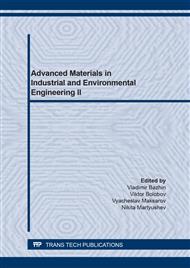[1]
M.E. Solovev, T.F. Irzhak, V.I. Irzhak, Kinetics of formation of nanoparticles from first group metal carboxylates, Russian Journal of Physical Chemistry 89(9) (2015) 1642-1647.
DOI: 10.1134/s0036024415090290
Google Scholar
[2]
T. Saito, Y. Aizawa, T. Yamamoto, K. Tajima, T. Isono, T. Satoh, Kali metal carboxylate as an efficient and simple catalyst for ring-opening polymerization of cyclic esters, Macromolecules 51(3) (2018) 689-696.
DOI: 10.1021/acs.macromol.7b02566
Google Scholar
[3]
M.-L. Hu, A. Morsali, L. Aboutorabi, Lead (II) carboxylate supramolecular compounds: coordination modes, structures and nano-structures aspects, Coordination Chemistry Reviews 255(23-24) (2011) 2821-2859.
DOI: 10.1016/j.ccr.2011.05.019
Google Scholar
[4]
A.S. Filatov, M. Napier, V.D. Vreshch, N.J. Sumner, E.V. Dikarev, M.A. Petrukhina, From solid state to solution: advancing chemistry of BI-BI and BI-RH paddlewheel carboxylates, Inorganic Chemistry 51(1) (2012) 566-571.
DOI: 10.1021/ic202089p
Google Scholar
[5]
A.N. Mikhailova, G.P. Kayukova, V.M. Babayev, G.A. Batalin, A.V. Vakhin, Comparative influence's research of the compound of metals carboxylates on the generation and composition of hydrocarbons from domanic deposits at steam-thermal effect in CO2 environment, Journal of Petroleum Science and Engineering 186 (2020) 106699.
DOI: 10.1016/j.petrol.2019.106699
Google Scholar
[6]
E. G. Palacios, G. Juárez-López, A. J. Monhemius, Infrared spectroscopy of metal carboxylates. II. Analysis of Fe (III), Ni and Zn carboxylate solutions, Hydrometallurgy 72(1-2) (2004) 139-148.
DOI: 10.1016/s0304-386x(03)00137-3
Google Scholar
[7]
A. Krief, A. Kremer, Synthesis of alkali metal carboxylates and carboxylic acids using wet and anhydrous alkali metal hydroxides, Chemical Reviews 110(8) (2010) 4772-4819.
DOI: 10.1021/cr9003506
Google Scholar
[8]
C.N.R. Rao, S. Natarajan, R. Vaidhyanathan, Metal carboxylates with open architectures, Angewandte Chemie - International Edition 43(12) (2004) 1466-1496.
DOI: 10.1002/anie.200300588
Google Scholar
[9]
V.D. Makhaev, P.E. Matkovskii, L.A. Petrova, V.D. Sasnovskaya, Solid-phase mechanochemical synthesis of zirconium tetracarboxylates, Russian Chemical Bulletin 59(9) (2010) 1735-1739.
DOI: 10.1007/s11172-010-0305-y
Google Scholar
[10]
A.A. Momziakov, K.S. Fadeeva, T.R. Deberdeev, R.Y. Deberdeev, A.A. Zharov, A.A. Berlin, A study of the regularities of the solid-phase synthesis of metal stearates, Russian Journal of Physical Chemistry 13(1) (2019) 68-74.
DOI: 10.1134/s1990793119010275
Google Scholar
[11]
O.D. Linnikov, Mechanism of aggregation and intergrowth of crystals during bulk crystallization from solutions, Crystal Research and Technology 43(12) (2008) 1268-1277.
DOI: 10.1002/crat.200800176
Google Scholar
[12]
D. Freyer, W. Voigt, Crystallization and phase stability of CaSO4 and CaSO4- based salts, Monatshefte für Chemie 134(5) (2003) 693-719.
DOI: 10.1007/s00706-003-0590-3
Google Scholar
[13]
C. Kajdas, Importance of mechanochemistry and tribochemistry for tribology, Tribologie und Schmierungstechnik 60(2) (2013) 45-50.
Google Scholar
[14]
A. Rossi, M. Eglin, F.M. Piras, K. Matsumoto, N.D. Spencer, Surface analytical studies of surface-additive interactions, by means of in situ and combinatorial approaches, Wear 256(6) (2004) 578-584.
DOI: 10.1016/j.wear.2003.10.001
Google Scholar
[15]
А. М. Ivanov, S. D. Pozhidaeva, RU Patent 2251529 (2005).
Google Scholar
[16]
S. D. Pozhidaeva, A. M. Ivanov, D. A. Sotnikova, A. Yu. Eliseeva, Interaction of Copper (II) oxide with monobasic mineral acids under model condition and in the presence of metallic copper, Russian Journal of inorganic chemistry 58(12) (2013) 1428-1433.
DOI: 10.1134/s0036023614010136
Google Scholar
[17]
S. D. Pozhidaeva, A. M. Ivanov, Regeneration of the Metal Oxidizer in the Near-Surface Layer as the Most Successful Variant of the Macrocycle in the Mechanism of Heterogeneous Heterophase Oxidation of the Metal, in A. G. Syrkov, K. L. Levine (Eds.), New materials preparation, properties and applications in the aspect of nanotechnology, Publishers Inc., New York, 2020, pp.189-196.
Google Scholar


